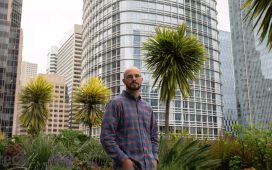The Nintendo Switch ranks at the top of our list of best consoles, but it’s far from the only great handheld gaming console on the market. Although Sony, Microsoft, and Nintendo have largely ducked out of the dedicated gaming handheld space, other companies have stepped in to fill the void.
Whether you’re shopping for yourself or your favorite gaming friend, there are handhelds available for every budget and demographic.
For the enthusiast
The Valve Steam Deck
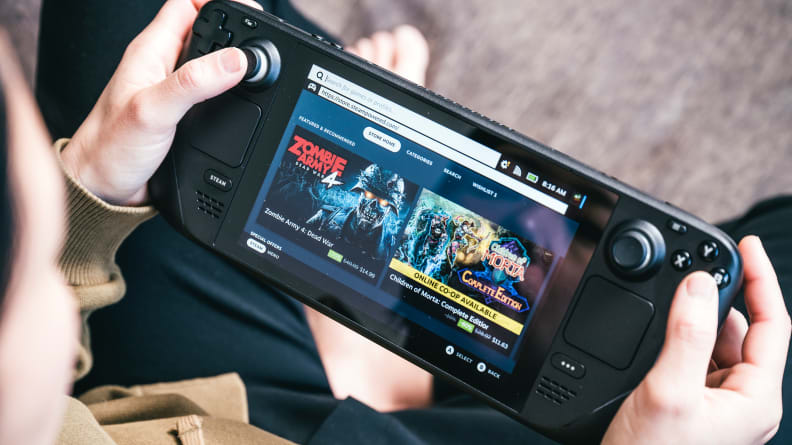
Credit:
Reviewed / Jackson Ruckar
The Steam Deck is a great companion device for PC Gamers.
There have been AMD-based gaming PC handhelds on the market since at least 2020 thanks to companies like Ayaneo, but Valve’s Steam Deck has them all beat on comfort and cost. Powered by a custom Linux distribution and AMD APU, the Steam Deck can run thousands of big-budget and indie games sold on Steam.
It’s relatively large at 11.7 x 4.6 x 1.93 inches, but its rounded palm corners and deep grips make gaming comfortable for hours on end. The 7-inch, 1280 x 800 pixel IPS display isn’t the greatest (it blooms and only covers 65% of the sRGB color space), but strikes the right balance between size and resolution—native PC games never look stretched or squished. The buttons, triggers, D-pad, and thumbsticks are responsive and feel much better in every way compared to the Nintendo Switch’s shallow counterparts.
Then there’s the price. For only $399—or less if you have money in your Steam wallet—the base 64GB Steam Deck can easily be upgraded with a higher capacity 2230 NVMe storage drive, all the way up to 1TB and beyond for less than Valve’s $650 top-tier 512GB model.
The Deck’s versatility is another major selling point; you can use it as an HTPC in the living room, emulate games on it up to the Nintendo Switch, and even install Windows 10 or 11.
If you buy a Steam Deck, you’re also buying into a community of more than one million owners, and Valve’s excellent customer support. Expect fast shipping times, robust warranty support, quick troubleshooting turnaround time, and the ability to find the answers to any questions you might have online.
The Logitech G Cloud
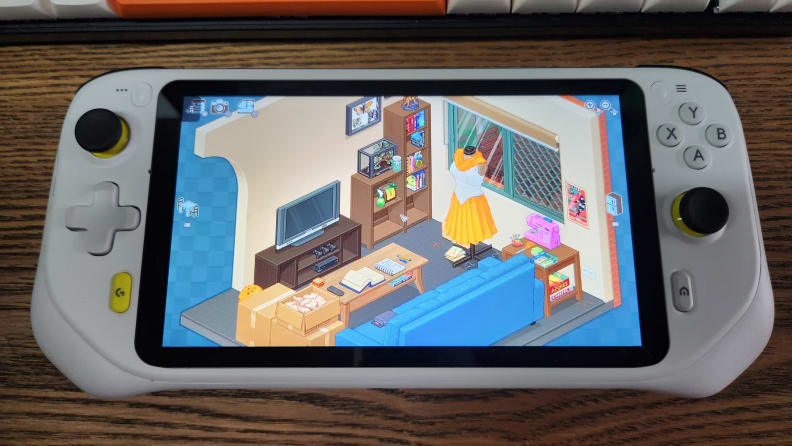
Credit:
Reviewed / Joanna Nelius
The Logitech G Cloud is an excellent handheld for anyone who wants to play streamed games from their couch.
If you mostly game from your couch or bed and need a device with at least eight hours of battery life, check out the Logitech G Cloud Gaming Handheld. Don’t let the ‘cloud gaming’ part put you off, either. If you have a strong and reliable internet connection, you won’t be able to tell the difference between gaming on the Logitech G and the Steam Deck or other handheld consoles talked about in this article.
The Logitech G’s 7-inch, 1080p display not only produces vivid colors but its size and resolution make the text in games like Cyberpunk 2077 much easier to read without adjusting the UI settings in-game. It’s also a tad lighter (16.3 ounces) and more comfortable to hold than the Steam Deck (23.5 ounces). Small hands rejoice!
With regards to app compatibility, the Logitech G can run cloud gaming services such as GeForce Now, Xbox Cloud Gaming, the indie game-focused Utomik, and any other cloud-gaming app available on Android. (Keep in mind the differences between each service, such as game availability and latency, aren’t controlled by Logitech.) You can also connect the Logitech G to your gaming PC via Steam Link and play that way, but your PC will need to be turned on and logged into Steam for this to work.
One downside compared to a similar device like the Razer Edge is that the Logitech G doesn’t come with a cellular chip. So, if you want to cloud game over a 5G cellular connection you’ll need to have a hotspot-capable cell phone to tether it to. This can work seamlessly, but if there are too many people in your vicinity or if you are too far away from a 5G tower, it won’t.
However, Logitech designed this device to use at home or anywhere with a stable and fast Wi-Fi connection, and it passed our tests in that regard with flying colors. It’s not a direct competitor to the Steam Deck, Switch, and other gaming handhelds, but if you don’t want to be locked into a single ecosystem, the Logitech G Cloud Gaming Handheld lets you play both PC and console games from a single device without having to mess around with bulky hardware.
For the retro game fan
The Retroid Pocket 3+

Credit:
Reviewed / Jonathan Hilburg
Emulate GameCube games and more with the Retroid Pocket 3+.
If you’re not interested in the latest games and just want to delve into decades of older titles, the Retroid Pocket 3+ might be just the thing. For $150, you get a pocketable Android handheld that imitates (or rips off) the Nintendo Switch Lite but has a much more diverse library.
Everything from the build quality to the snappy feel of the buttons is uniformly excellent, barring the, unfortunately, placed down-firing speakers and start|select rocker. The 4.7-inch, 1334 x 750-pixel IPS touchscreen pops and, although it isn’t OLED, has fantastic contrast and black levels. It even gets up to 450 nits peak brightness, which is more than enough to play outside during the daytime. The tactile and responsive YXBA face buttons are more than accurate enough for platformers where you need pixel-perfect response times—the best our reviewer has ever tested.
The Retroid Pocket 3+’s Unisoc Tiger T618 processor is also beefy enough to handle emulation up to PlayStation 2 and GameCube games, and more than powerful enough for even older console games. The 16:9 screen means that PSP games will run at their native resolution without letterboxing, and you can even install widescreen hacks to breathe new life into older 3D titles.
Retroid also makes it easy to get up and running by loading up each Pocket 3+ with emulators before shipping them out. The included 128GB of internal storage should be enough to hold dozens, if not hundreds of games depending on how old they are. You can also add up to 1TB of additional storage using the SD card slot.
If modern titles are more your thing, the Retroid Pocket 3+ can stream games just fine from your home PC over Steamlink or Moonshine. Retroid also included a mini-HDMI port so you can turn the Pocket 3+ into a home console, and you can even pair Bluetooth controllers to it for multiplayer.
The Pocket 3+ comes in a few fun colorways that throwback to past consoles and handhelds; when was the last time you bought anything in clear purple from Sony, Nintendo, or Microsoft?
For the budget-minded
The Retroid Pocket 2+
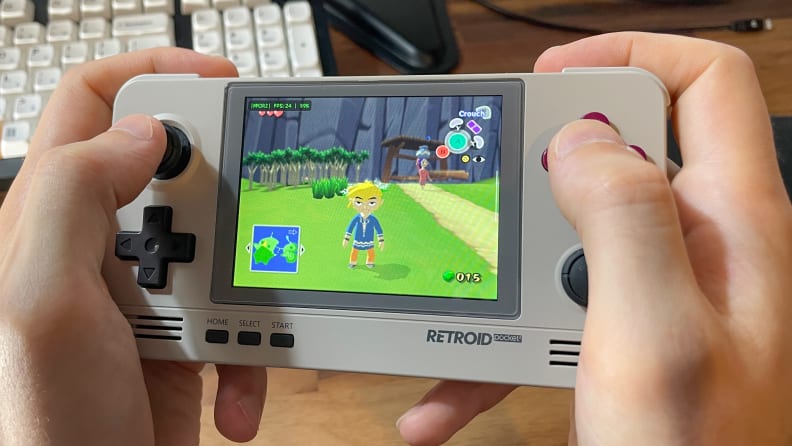
Credit:
Reviewed / Jonathan Hilburg
The small screen is all but unreadable when streaming newer titles.
Although Retroid has stopped selling the Pocket 2+ on its website, it’s a fantastic retro emulation handheld and still available on Amazon. In our review, we noted its size and affordability (when it was retailing for $99 instead of $130) made it a no-brainer for gamers on the go.
The 3.5-inch, 640 x 480 screen isn’t nearly as good as its successors’, but for emulating Game Boy and Game Boy Advance or Nintendo 64 games, it’s more than enough. The Pocket 2+ isn’t a direct competitor of the Pocket 3+; it’s a cheaper alternative that’s perfect for throwing in your bag or pocket and playing on a long commute. It can also stream games from your PC, but you’re better off sticking with emulating older titles given the screen size. Retroid has similarly preloaded the Pocket 2+ with emulators, so all buyers need to do is transfer over their game ROMs.
The Pocket 2+’s older Unisoc Quad-core Tiger T310 processor can handle everything up to the PlayStation 1, N64, and Dreamcast era with ease, putting thousands of titles at your fingertips. The buttons and D-pad aren’t quite on par with the Pocket 3+, but again, it is in a lower price tier.
While it makes sense that Retroid would want to focus on its more expensive offerings and fulfilling its growing backlog of Pocket 3+ orders, I can’t help but disagree with their decision to discontinue the Pocket 2+. For most people, it’s a fantastic way to experience the games they grew up on while accessibly dipping their toes into the world of emulation.
Buy the Retroid Pocket 2+ from Amazon
For the purist
The Analogue Pocket
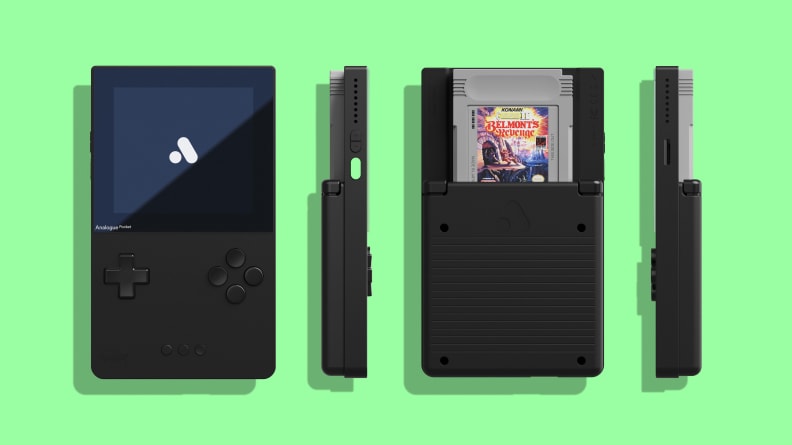
Credit:
Analogue
The Analogue Pocket: no emulation, real game cartridges.
The $220 Analogue Pocket is the only entry on this list that takes physical cartridges; instead of emulating older games, it plays them as they were intended. That includes the Game Boy, Game Boy Color, and Game Boy Advance, but Game Gear, Neo Geo Pocket Color, and Atari Lynx games are all playable with the right adapters.
Anyone with a library of old cartridges and decades-old hardware without backlighting should be thrilled by Analogue’s elegant combination of authenticity and upgrades. It easily and cheerfully plays everything you can throw at it—and there’s a gleeful ridiculousness about hooking it up to the (optional) dock to play games originally made for a 3-inch screen on a 55-inch television.
The Analogue Pocket’s screen is gorgeous (with a 3.5-inch, 1600 × 1440-pixel display for a ludicrous 615 pixels-per-inch density), and the display options let you choose between “pixel perfect” reproductions or simulating the desaturated colors of the original hardware. That’s a great addition because developers often used harsh colors in their games knowing the Game Boy Advance screen would wash them out.
There’s an entire world beyond games, too. The included Nanoloop synthesizer/music studio is fun, though you’ll definitely want to find a tutorial to get started. You can make and share your own GB Studio games, and there’s a host of new possibilities offered by the OpenFPGA firmware update.
You’re paying a premium to play a system that uses original hardware rather than emulation for just the base functionality. That may not be worth it for everyone. But when you add in extras like the dock compatibility, composition software, GB Studio games, and now the open-source cores that let you mimic and emulate other systems, you get enough out of this handheld that you don’t have to be a retro purist to enjoy it.
The product experts at Reviewed have all your shopping needs covered. Follow Reviewed on Facebook, Twitter, Instagram, TikTok, or Flipboard for the latest deals, product reviews, and more.
Prices were accurate at the time this article was published but may change over time.

